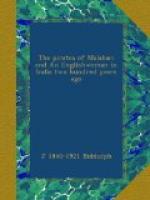[Illustration: Map]
[1] According to the Company’s instructions
in 1675, writers were to
receive no salary at all for
the first five years, and after that L10
a year. In 1699 the Court
of Directors settled the salaries of
merchants at L60, factors
at L40, and writers at L20 per annum (Bruce);
but in 1716 the salaries were
as above stated.
[2] The London Company and the English East India
Company were amalgamated
in 1708.
[3] 1674.
[4] It was afterwards re-established, and again abolished in Boone’s time.
[5] Bombay was subordinate to the Surat factory till 1685.
[6] Four years after returning to England, Keigwin
was given the command
of a frigate. In 1690
he accompanied the expedition against the French
in the West Indies, and fell
at the head of his men in the assault of
Basseterre, St. Christopher’s.—Dic.
Nat. Bio.
[7] Hansard, 1754.
[8] The first General Order issued by the Commander-in-Chief
in Madras was
dated the 22nd November, 1772.
[9] The lari was the well-known hook money of the
Persian Gulf. It was
worth about sixpence.
CHAPTER VI
EXPEDITION AGAINST KENNERY
Sivajee’s occupation of Kennery—A naval action—Minchin and Keigwin—Bombay threatened—The Seedee intervenes—Conajee Angria occupies Kennery—Boone sails with the expedition—Manuel de Castro—Futile proceedings—Force landed and repulsed—Second landing—Manuel de Castro’s treachery—Gideon Russell—Bad behaviour of two captains—Defeat—Attack abandoned—The St. George—The Phram—Manuel de Castro punished—Bombay wall completed—Angria makes overtures for peace—Boone outwitted.




